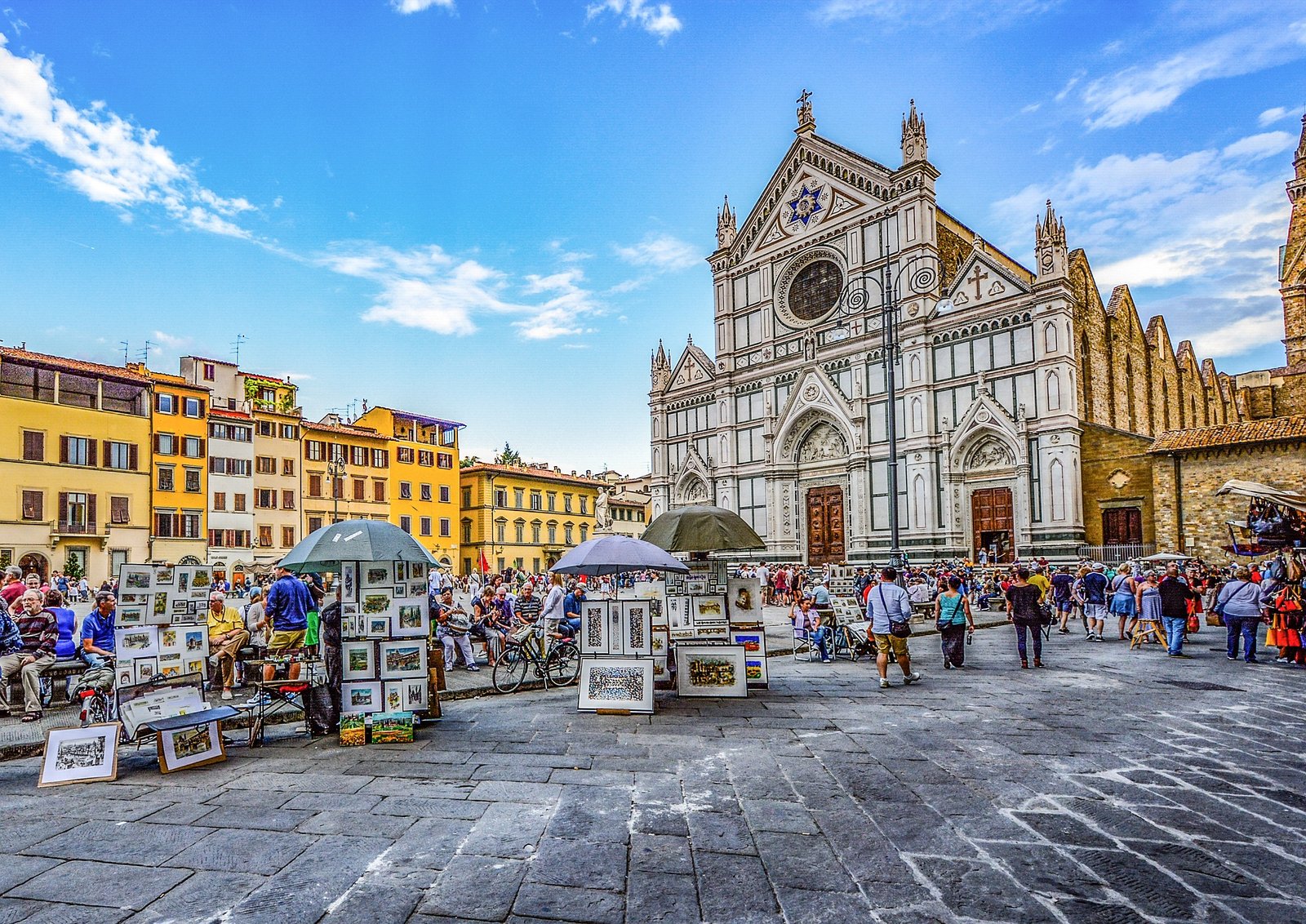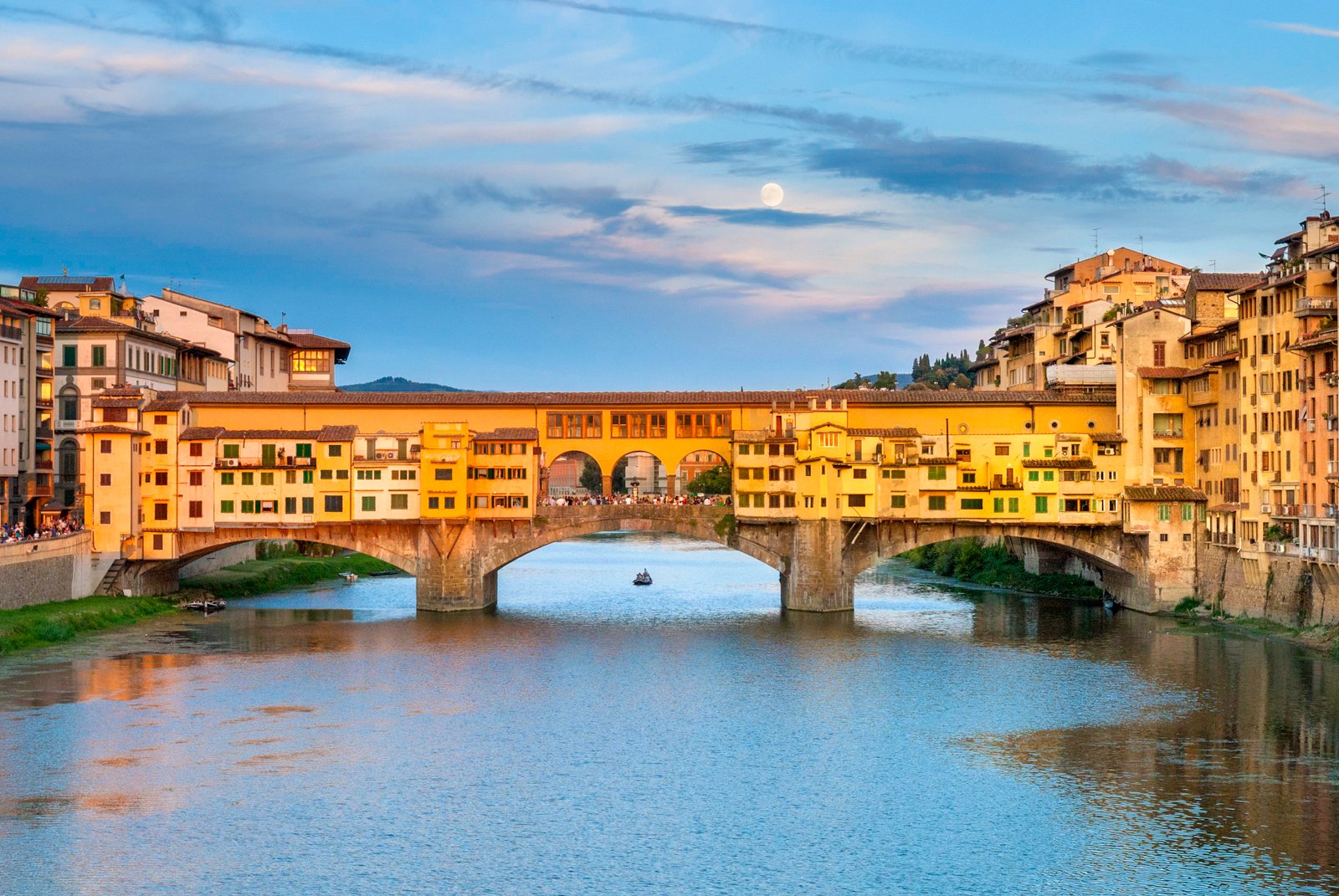Main tourist attractions
Historical monuments
- Cathedral of Santa Maria del Fiore (Duomo): An iconic symbol of Florence with its stunning dome designed by Brunelleschi.
- Ponte Vecchio: A medieval stone bridge famous for its shops built along it.
- Palazzo Vecchio: The town hall of Florence, offering panoramic views of the city.
Museums and galleries
- Uffizi Gallery: Home to an extensive collection of Renaissance art, including works by Botticelli and Leonardo da Vinci.
- Accademia Gallery: Famous for Michelangelo’s David.
- Pitti Palace: A vast Renaissance palace housing several important museums.
Parks and natural areas
- Boboli Gardens: A historic park behind the Pitti Palace, perfect for leisurely strolls.
- Cascine Park: The largest public park in Florence, ideal for picnics and outdoor activities.
Beaches
While Florence is inland and does not have beaches, nearby coastal towns like Viareggio and Forte dei Marmi offer beautiful seaside escapes.
Local culture: traditions and festivals
Florence is rich in traditions and festivals. The Scoppio del Carro (Explosion of the Cart) is an Easter tradition where a cart filled with fireworks is ignited. The Calcio Storico is a historic football match played in June, combining soccer, rugby, and wrestling. Additionally, the Festa della Rificolona in September is a lantern festival celebrated with parades and music.
Sports and teams
Soccer is the most popular sport in Florence, with ACF Fiorentina being the city’s main team. The city also hosts various sporting events, including marathons and cycling races.
Gastronomy: food and restaurants
Typical dishes
- Bistecca alla Fiorentina: A thick, juicy T-bone steak.
- Ribollita: A hearty vegetable and bread soup.
- Lampredotto: A traditional Florentine street food made from the fourth stomach of a cow.
Recommended dining areas
- Oltrarno: Known for its authentic trattorias and local cuisine.
- Santa Croce: Offers a mix of traditional and contemporary dining options.
- San Lorenzo: Famous for its food markets and street food.
Handicrafts and local shopping
Florence is renowned for its leather goods, gold jewelry, and handmade paper. San Lorenzo Market and Ponte Vecchio are popular shopping destinations. Via de’ Tornabuoni is the place to go for high-end fashion and luxury brands.
Accommodation tips
Recommended areas
- Centro Storico: Ideal for history buffs, close to major attractions.
- Oltrarno: Perfect for those seeking a more local experience.
- Santa Maria Novella: Convenient for travelers, near the main train station.
Types of accommodation
- Hotels: From budget-friendly options to luxury five-star hotels.
- Bed and Breakfasts: Cozy and charming, offering a personal touch.
- Hostels: Affordable and social, ideal for backpackers.
Entertainment and activities
Outdoor activities
- Hiking: Explore the nearby Tuscan hills and countryside.
- Cycling: Rent a bike and ride along the Arno River.
Nightlife
Florence boasts a lively nightlife scene with bars, clubs, and live music venues. Piazza Santo Spirito and Santa Croce are popular areas for nightlife, offering everything from wine bars to dance clubs.
Transportation
Getting to Florence
Florence is served by Amerigo Vespucci Airport, with flights from major cities worldwide. Additionally, it is well-connected by train, with high-speed services from cities like Rome and Milan.
Local transportation
- Buses: Numerous routes covering the entire city.
- Trams: A convenient way to travel within the city.
- Car and Bike Rentals: Available for those who prefer to explore at their own pace.
Best time to visit
The best time to visit Florence is during the spring (April to June) and fall (September to October) when the weather is pleasant, and the tourist crowds are smaller.
Safety and precautions
Florence is generally safe for tourists, but it’s essential to take standard precautions. Avoid displaying valuables, be cautious in crowded areas, and use reputable transportation services.

Florence-park
Suggested itineraries
1 Day
- Morning: Visit the Duomo and climb to the top for a panoramic view.
- Afternoon: Explore the Uffizi Gallery.
- Evening: Dinner in Oltrarno.
3 Days
- Day 1: Follow the 1-day itinerary.
- Day 2: Visit the Accademia Gallery and Palazzo Vecchio.
- Day 3: Explore Boboli Gardens and Pitti Palace.
1 Week
- Day 1-3: Follow the 3-day itinerary.
- Day 4: Day trip to Pisa or Siena.
- Day 5: Visit the Bargello Museum and Santa Croce.
- Day 6: Explore the San Lorenzo Market and Medici Chapels.
- Day 7: Relax in Cascine Park and enjoy a farewell dinner in Santa Croce.
Currency, language, and customs
The currency in Florence is the Euro (EUR). The official language is Italian, but English is widely spoken in tourist areas. Florentines are known for their warm hospitality, and it’s customary to greet people with a handshake or a kiss on the cheek.

Florence-Market
Conclusion
Florence is a city that seamlessly blends its rich history with modern vibrancy. Whether you’re an art lover, a foodie, or an adventure seeker, Florence offers an unforgettable experience. Plan your trip today and immerse yourself in the magic of Florence!
Table of contents
| Category |
Details |
| Historical monuments |
Duomo, Ponte Vecchio, Palazzo Vecchio |
| Museums |
Uffizi Gallery, Accademia Gallery, Pitti Palace |
| Parks |
Boboli Gardens, Cascine Park |
| Dining areas |
Oltrarno, Santa Croce, San Lorenzo |
| Accommodation |
Centro Storico, Oltrarno, Santa Maria Novella |
| Outdoor activities |
Hiking in Tuscan hills, Cycling along the Arno River |
| Nightlife |
Piazza Santo Spirito, Santa Croce |
| Transportation |
Buses, Trams, Car and Bike Rentals |
| Best time to visit |
April to June, September to October |
| Safety tips |
Avoid displaying valuables, be cautious in crowded areas |
| Suggested itineraries |
1 Day, 3 Days, 1 Week |
| Currency and language |
Euro (EUR), Italian |










